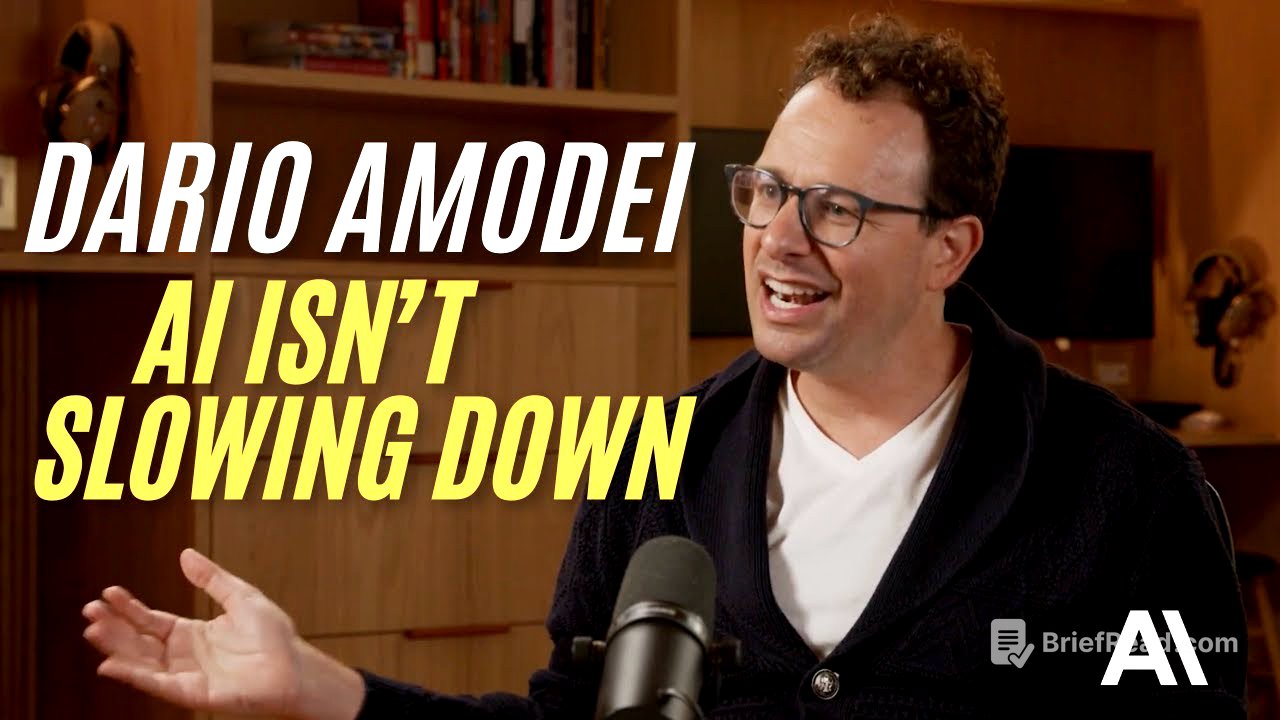TLDR;
In this interview, Dario Amodei, CEO of Anthropic, discusses the rapid advancements in AI, addressing concerns about job displacement, safety, and the concentration of power in the industry. He emphasizes the importance of responsible scaling, transparency, and ethical considerations in AI development. Amodei defends his warnings about AI risks, highlighting the need for serious engagement with both the potential benefits and dangers of the technology. He also touches on Anthropic's business model, competition with larger tech companies, and his personal motivations for working in AI.
- AI capabilities are improving exponentially, necessitating urgent attention to safety and economic impacts.
- Anthropic focuses on business use cases for AI, emphasizing talent density and capital efficiency.
- Amodei advocates for a "race to the top" in AI development, prioritizing responsible scaling and transparency.
AGI timelines and the exponential case [3:33]
Dario Amodei addresses his shorter timeline for AI development compared to other major lab leaders, clarifying that he avoids using terms like AGI and super intelligence because he finds them meaningless and more like marketing terms. Despite this, he is bullish about the rapid improvement of AI capabilities, emphasizing the exponential growth in AI model performance with increased compute, data, and new training methods. He notes that while predicting societal impacts is difficult, the underlying technology is becoming more predictable. Amodei acknowledges a 20-25% chance that model improvements could plateau in the next two years due to factors like data or compute availability, but he remains confident in the overall trend.
Scaling update: diminishing returns, continual learning, new techniques [9:49]
Amodei counters the notion of diminishing returns in AI scaling, citing Anthropic's progress in coding as an example where each new model has shown substantial improvement. He addresses the issue of continual learning, acknowledging that while current models may lack this capability, they can still achieve significant economic impact. Amodei explains that context windows are getting longer, allowing models to learn during conversations, and there's potential to expand context length further. He also mentions ongoing research into learning and memory techniques to update model weights. Anthropic is also consistently developing new techniques to improve their models, including architectural enhancements, data improvements, and training method advancements.
Scale & competition: resources, talent wars [16:47]
Amodei discusses Anthropic's competitive position against larger tech companies with vast resources, stating that the company has raised nearly $20 billion and is building data centers comparable in size to those of its competitors. He emphasizes Anthropic's focus on talent density and its ability to compete effectively due to capital efficiency. Amodei addresses the talent war, noting that Anthropic has been successful in retaining employees despite lucrative offers from other companies like Meta. He attributes this to the company's mission alignment and its commitment to fair compensation principles, rejecting the idea of compromising its culture to retain talent.
Business model and revenue ramp [20:10]
Amodei explains Anthropic's business model, highlighting that the majority of sales come through its API, although its apps business is also growing rapidly. He emphasizes the company's bet on business use cases for AI, believing that enterprise applications will be even more significant than consumer applications. Amodei argues that focusing on business use cases provides better incentives to improve models, as businesses are more likely to value and pay for advancements in specific areas like biochemistry. He also touches on the decision to focus on coding as a key use case, citing its fast adoption and the value of coding models in developing the next generation of AI.
Economics: pricing changes, inference costs & profitability [27:26]
Amodei addresses the complexities of pricing schemes and rate limits, acknowledging that Anthropic has adjusted its pricing for larger models like Opus due to a better understanding of how users were utilizing them. He clarifies that the company is not losing money, even with some users getting better deals through consumer subscriptions. Amodei expects the price of providing a given level of intelligence to decrease over time, while the price of frontier intelligence may remain stable, but the value created will increase significantly. He explains that larger models cost more to run than smaller models, and improvements in inference efficiency are constantly being made. Amodei describes the company's profitability in terms of each model's revenue versus its training cost, noting that while the company may be unprofitable overall due to ongoing investments in new models, each model itself is profitable.
Open source vs. hosted frontier models [36:29]
Amodei shares his perspective on open source AI models, arguing that they don't work the same way as in other areas of technology. He emphasizes that because you can't see inside the model, it's often called open weights instead of open source. He believes that the benefits of open source, such as many people working on it in an additive way, don't quite apply in the same way to AI. Amodei views open source as a red herring, focusing instead on whether a model is good and better than Anthropic's models at specific tasks. He points out that open source models still need to be hosted on the cloud for inference, and Anthropic offers cloud-based fine-tuning and interpretability tools.
Personal background: SF, family, father’s illness [40:10]
Amodei discusses his upbringing in San Francisco, noting that he had no interest in the tech boom that was happening around him. He shares his close relationship with his parents, who instilled in him a strong sense of responsibility and a desire to make the world better. Amodei talks about his father's illness and death, which led him to switch from theoretical physics to biology in an attempt to address human illnesses. He explains that his eventual transition to AI was motivated by the belief that AI could bridge the gap in understanding the complexity of biological problems. Amodei expresses his frustration with being labeled a doomer, emphasizing that he understands the benefits of AI and the urgency of solving relevant problems.
Governance & safety: “race to the top” and the control debate [54:15]
Amodei addresses criticisms that he wants to control the AI industry, calling it an outrageous lie. He advocates for a "race to the top," where companies compete to set an example for responsible scaling, transparency, and ethical practices. Amodei highlights Anthropic's responsible scaling policies, interpretability research, and dangerous capabilities evaluations as examples of this approach. He discusses his departure from OpenAI, citing differences in organizational decisions and the need for trustworthy leadership. Amodei emphasizes the importance of balancing the benefits and risks of AI, and he expresses concern that the progress in safety is not keeping up with the speed of technological advancement. He is doing the best he can do, which is to invest in safety technology to speed up the progress of safety.









